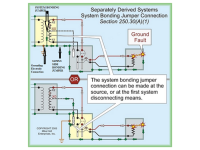fastline
Senior Member
- Location
- midwest usa
I must be having mental fade. I am not at the equipment currently but I wanted to confirm something. I was restarting some equipment yesterday so I was checking voltages and such. Equipment runs off a 480 to 208 transformer. All loads are 3P, no single phase loads. However, for whatever reason I checked all legs to ground. Two were 120, one was 102. All phase to phase was find, and 480 checked out fine.
It dawned on me that even if that isolation transformer has a neutral tap for L-N, we did not carry it out because it wasn't needed. I cannot remember if isolation transformers normally have a bonded N/G? This might explain 'some' things, but I am focused right now on ground inspections. I know we installed a ground rod for the transformer as well as bonded to the steel in the metal building through unistrut and all switch gear is grounded through that.
I guess more than anything, I am vetting grounds right now but also trying to figure out why I would have L-G voltage without a neutral bond?
It dawned on me that even if that isolation transformer has a neutral tap for L-N, we did not carry it out because it wasn't needed. I cannot remember if isolation transformers normally have a bonded N/G? This might explain 'some' things, but I am focused right now on ground inspections. I know we installed a ground rod for the transformer as well as bonded to the steel in the metal building through unistrut and all switch gear is grounded through that.
I guess more than anything, I am vetting grounds right now but also trying to figure out why I would have L-G voltage without a neutral bond?


